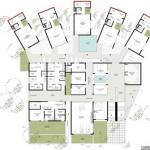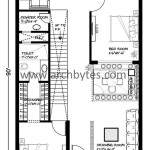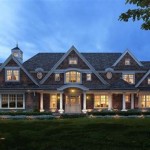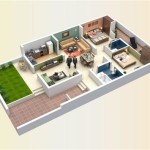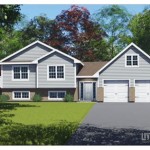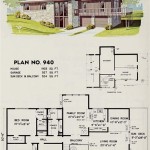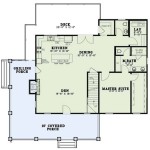Beach House Floor Plans On Stilts: Elevated Living Redefined
The allure of a beach house is undeniable, offering a serene escape with breathtaking ocean views and the soothing sounds of crashing waves. However, building directly on the ground in a coastal environment presents numerous challenges, including the threat of flooding, erosion, and pest infestations. This is where the concept of constructing beach houses on stilts, also known as pilings, becomes an advantageous and, in many cases, a necessary design choice. Elevating a beach house not only mitigates these risks but also opens up a range of design possibilities, creating unique and functional living spaces. This article explores the considerations and benefits associated with beach house floor plans on stilts, highlighting key areas that influence design and construction.
Addressing Environmental Concerns Through Elevated Design
One of the primary motivations for building a beach house on stilts is to address the inherent environmental risks associated with coastal locations. Floodplains are common in coastal areas, and a house built at ground level is inherently vulnerable to water damage during storms or high tides. Elevating the structure above the base flood elevation (BFE), as determined by local building codes and FEMA regulations, is a crucial step in protecting the property and its occupants.
Beyond flood protection, stilts also help to minimize erosion. The natural movement of sand and soil along the coastline can undermine foundations and destabilize structures built directly on the ground. By elevating the house, the impact of erosion is significantly reduced, as the pilings are driven deep into the ground, providing a more secure and stable foundation. Furthermore, the elevated design allows for natural drainage and prevents the build-up of water around the base of the house, further mitigating erosion risks.
Another environmental benefit of building on stilts is the reduction in impact on the surrounding ecosystem. Ground-level construction can disrupt natural habitats and interfere with the movement of wildlife. Elevating the house creates an open space underneath, allowing for the free flow of air and water, and preserving the natural environment to a greater extent. This is particularly important in ecologically sensitive areas, such as wetlands or dune systems.
Choosing the right type of pilings is also crucial in addressing environmental concerns. Options include timber pilings, concrete pilings, and steel pilings, each with its own set of advantages and disadvantages. Timber pilings are a traditional choice, but they are susceptible to rot and insect damage. Concrete pilings are more durable and resistant to these issues, while steel pilings offer the highest strength and longevity but are also the most expensive. The selection should be based on a careful assessment of the soil conditions, the local climate, and the specific requirements of the project.
Optimizing Space and Functionality in Elevated Beach House Designs
Building a beach house on stilts not only offers environmental protection but also creates unique opportunities for optimizing space and functionality. The elevated design allows for the creation of a flexible ground-level space that can be used for a variety of purposes.
One common use of the space beneath a stilt house is for parking. In coastal areas where parking is often limited and expensive, having covered parking under the house can be a significant advantage. This keeps vehicles protected from the elements and provides convenient access to the house.
Another popular option is to create an outdoor living area under the house. This can include a covered patio, a grilling area, or even a space for outdoor games. The elevated structure provides shade and protection from the sun and rain, making it an ideal space for relaxing and entertaining.
Storage is another important consideration in beach house design, and the space under a stilt house can be an excellent place to store beach gear, outdoor furniture, and other items that are not needed inside the house. This helps to keep the interior spaces clutter-free and organized.
In some cases, the space under the house can even be enclosed to create additional living space. This can be particularly appealing in areas where square footage is limited or expensive. However, it's important to note that enclosing the space under the house may require compliance with additional building codes and regulations, especially in flood-prone areas. It's also critical to ensure proper ventilation and drainage to prevent moisture problems.
Regarding the floor plan of the living area itself, an elevated design often lends itself to an open concept layout. This allows for unobstructed views of the ocean and creates a sense of spaciousness. Large windows and sliding glass doors can further enhance the connection between the interior and exterior spaces, bringing in natural light and allowing for easy access to decks and balconies.
The placement of bedrooms and bathrooms should also be carefully considered. Bedrooms are often located on the upper floors to maximize privacy and views, while bathrooms should be strategically placed for convenience and accessibility. The overall design should aim to create a comfortable and functional living space that meets the specific needs of the occupants.
Integrating Aesthetic Considerations with Structural Integrity
While structural integrity and functionality are paramount in beach house design, aesthetic considerations are equally important. A well-designed beach house should not only be safe and practical but also visually appealing and harmonious with its surroundings. Achieving a balance between these factors requires careful planning and attention to detail.
The architectural style of the house should be chosen to complement the surrounding landscape and the local architectural vernacular. Coastal styles often feature elements such as exposed beams, shingle siding, and large windows. However, it is also possible to incorporate modern or contemporary elements while maintaining a cohesive and aesthetically pleasing design.
The exterior color palette should be chosen to reflect the natural colors of the beach and the ocean. Light and airy colors, such as white, beige, and light blue, are popular choices, as they create a sense of calmness and serenity. Accents of bolder colors can be used to add visual interest and personality.
The design of the stilts themselves can also contribute to the overall aesthetic of the house. While the primary function of the stilts is to provide structural support, they can also be designed to be visually appealing. Options include using decorative pilings, incorporating architectural details, or painting the stilts to match the color scheme of the house.
Landscaping is another important aspect of beach house design. Native plants and vegetation should be used to enhance the natural beauty of the surroundings and to provide erosion control. The landscaping can also be used to create privacy and to define outdoor living spaces.
Interior design should also be carefully considered to create a cohesive and inviting living space. Natural materials, such as wood, stone, and bamboo, are often used to create a warm and organic feel. The furniture should be comfortable and functional, and the décor should reflect the coastal setting.
Lighting is a crucial element in creating a welcoming and comfortable atmosphere. Natural light should be maximized through the use of large windows and skylights. Artificial lighting should be carefully planned to provide both functional and ambient lighting. Dimmer switches can be used to adjust the lighting levels to create different moods and to conserve energy.
In conclusion, designing beach house floor plans on stilts requires a comprehensive approach that considers environmental factors, functional needs, and aesthetic preferences. By carefully addressing these aspects, it is possible to create a beautiful, safe, and sustainable living space that enhances the coastal experience.

Coastal Stilt House Plan With Elevator And Second Level Living Space 765044twn Architectural Designs Plans

Elevated Piling And Stilt House Plans Coastal From Home

Beach House Plans Coastal Home Great Design

House Design Plan Ch539 3 Stilt Plans On Stilts Carriage

Featured House Plan Bhg 3928

Plan 44026td Classic Florida Er Beach House Plans Coastal

Elevated Piling And Stilt House Plans Coastal From Home

Casual Informal And Relaxed Define Coastal House Plans

Modern Beach House On Stilts Designs Ideas Dornob

Family S 576 Sq Ft Stilt Beach House


